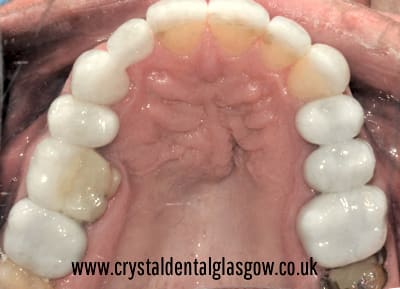White fillings, made from the latest composite material, look a lot better than old dark metal fillings. That's why many of our patients like the idea of replacing their old fillings with something more tooth-coloured.
But what are white fillings? In this short video Dr Murphy explains the difference between white fillings and inlays which are generally for larger dental repairs.
All About White Fillings
The difference is clear - you could even say black and white. Take a look at this recent cosmetic dentistry case in our Glasgow practice and you can see the before-and-after results of replacing old dark amalgam fillings with more cosmetic tooth-coloured fillings. It is fair to say the patient was delighted.


Originally white fillings were used mostly on the front teeth but now they can be deployed throughout the mouth. The technology has improved considerably and tooth-coloured fillings are a lot more durable now than they were.
Can you get white fillings on the NHS?
Not usually, although it is possible if you can prove you are unable to stand traditional type of fillings. Discuss it with your dentist.
What are they made of?
A composite resin created from tooth-coloured plastic mixed with silicon dioxide which bonds to the tooth. The great thing about the composite resin is we can match it to the shades of your own teeth, making it hard to spot the difference.
How much do white fillings cost?
The price of white fillings really depends on the size:
- Very Small - £35
- Small - £45 to 65
- Medium - £55 to 75
- Large - £65 to 100
What is an inlay?
Inlays and onlays in Glasgow are made in a laboratory and cemented on during a second visit to the dentist and prove a popular method for restoring the structure of your normal teeth after decay or damage.
What is the difference between an inlay and an onlay?
An inlay is carried out when the tooth structure to be replaced is within the cusp tips of the tooth.
If the damage is more extensive and the new structure covers the entire chewing surface including one or more tooth cusps, the procedure is called an onlay.
These are large fillings created in a laboratory and are carved into the shape of a tooth. They are ideal for very heavily filled teeth.
Composite Inlay or Belleglass Inlay
This is a large, strong filling made in a laboratory of white composite to look like tooth substance.
A composite inlay costs from £225-£400
Porcelain inlay
This is also large filling - even stronger than a composite inlay - made in a laboratory.
How much are porcelain inlays?
A porcelain inlay costs from £220-£375
